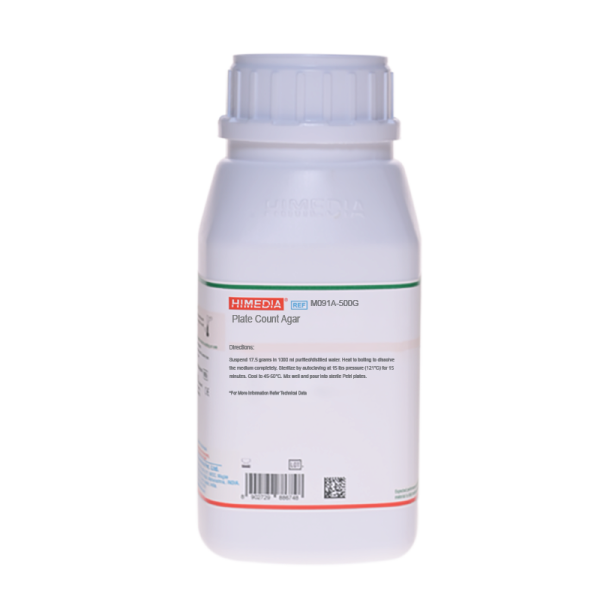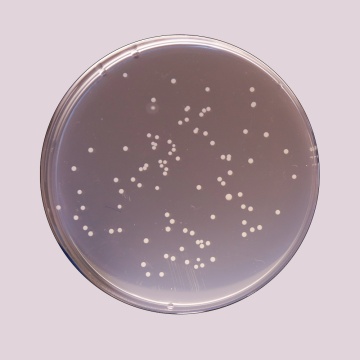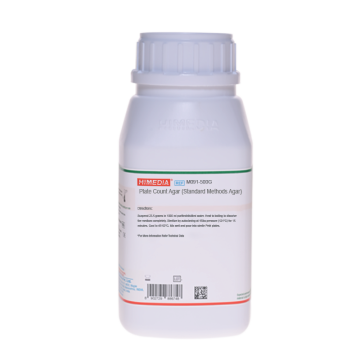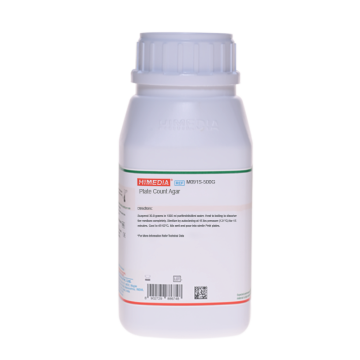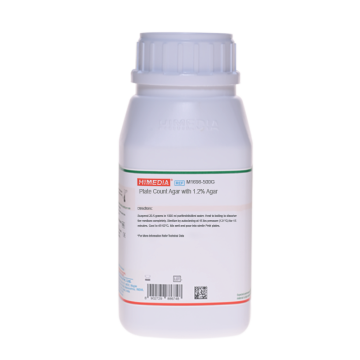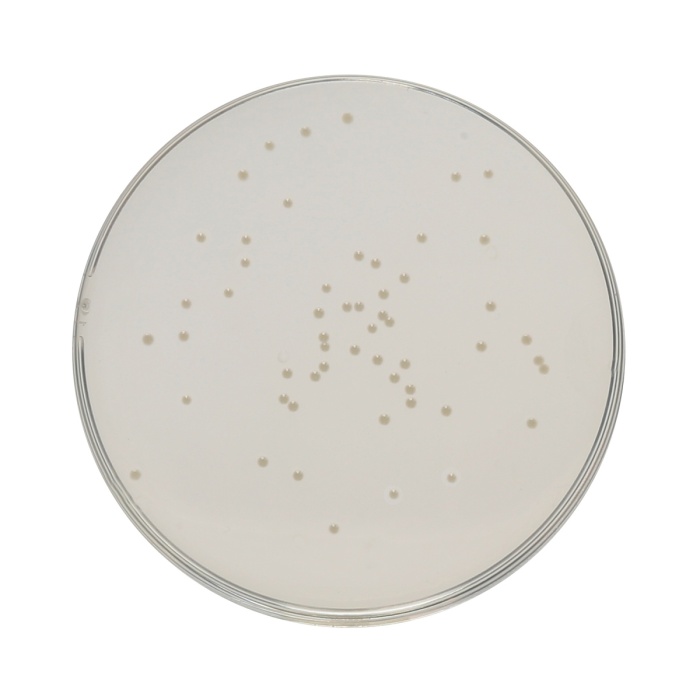 Your enquiry has been submitted
Your enquiry has been submitted
Plate Count Agar
Total Bacterial Count- Colony Count Method#CC293D
Intended Use
Recommended for determining plate counts of microorganisms in milk and dairy products by pour plate technique.
Composition
| Ingredients | Gms / Litre |
|---|---|
| Tryptone | 5.000 |
| Yeast extract | 2.500 |
| Dextrose (Glucose) | 1.000 |
| Agar | 9.000 |
Final pH (at 25°C): 7.0±0.2
**Formula adjusted, standardized to suit performance parameters
Directions
Suspend 17.5 grams in 1000 ml purified / distilled water. Heat to boiling to dissolve the medium completely. Sterilize by autoclaving at 15 lbs pressure (121°C) for 15 minutes. Cool to 45-50°C. Mix well and pour into sterile Petri plates.
Principle And Interpretation
Plate Count Agar is equivalent to the medium recommended by APHA for the isolation of microorganisms in milk and other dairy products (1).
Tryptone provides amino acids and other complex nitrogenous substances. Yeast extract supplies Vitamin B complex. APHA recommends pour plate technique. The samples are diluted and appropriate dilutions are placed in Petri plates. Sterile molten agar is added to these plates and plates are rotated gently to ensure uniform mixing of the sample with agar. Plate Count Agar is also used for the estimation of the number of live heterotrophic bacteria in water.
Type of specimen
Dairy samples
Specimen Collection and Handling
For dairy samples, follow appropriate techniques for sample collection and processing as per guidelines (1,4).
After use, contaminated materials must be sterilized by autoclaving before discarding.
Warning and Precautions
Read the label before opening the container. Wear protective gloves/protective clothing/eye protection/ face protection. Follow good microbiological lab practices while handling specimens and culture. Standard precautions as per established guidelines should be followed while handling specimens. Safety guidelines may be referred in individual safety data sheets.
Limitations
- Further biochemical and serological tests must be carried out for further identification.
Performance and Evaluation
Performance of the medium is expected when used as per the direction on the label within the expiry period when stored at recommended temperature.
Quality Control
Appearance Cream to yellow coloured homogeneous free flowing powder
Gelling Firm, comparable with 0.9% Agar gel.
Colour and Clarity of prepared medium Light yellow coloured clear to slightly opalescent gel forms in Petriplates.
Reaction
Reaction of 1.75% w/v aqueous solution at 25°C. pH: 7.0±0.2
pH
6.80-7.20
Cultural Response
Cultural characteristics after an incubation at 35 - 37°C for 18 - 24 hours.
| Organism | Inoculum (CFU) | Growth |
|---|---|---|
| Bacillus subtilis ATCC 6633 (00003*) | 50-100 | luxuriant |
| Escherichia coli ATCC 25922 (00013*) | 50-100 | luxuriant |
| Enterococcus faecalis ATCC 29212 (00087*) | 50-100 | luxuriant |
| Lactobacillus acidophilus ATCC 4356 (00098*) | 50-100 | luxuriant |
| Lactobacillus casei ATCC 9595 | 50-100 | luxuriant |
| Staphylococcus aureus subsp. aureus ATCC 25923 (00034*) | 50-100 | luxuriant |
| Streptococcus pyogenes ATCC 19615 | 50-100 | luxuriant |
Key :* - corresponding WDCM
Storage and Shelf Life
Store between 10-30°C in a tightly closed container and the prepared medium at 20-30°C. Use before expiry date on the label. On opening, product should be properly stored dry, after tightly capping the bottle in order to prevent lump formation due to the hygroscopic nature of the product. Improper storage of the product may lead to lump formation. Store in dry ventilated area protected from extremes of temperature and sources of ignition. Seal the container tightly after use. Product performance is best if used within stated expiry period.
Disposal
User must ensure safe disposal by autoclaving and/or incineration of used or unusable preparations of this product. Follow established laboratory procedures in disposing of infectious materials and material that comes into contact with sample must be decontaminated and disposed of in accordance with current laboratory techniques (2,3).
Reference
- American Public Health Association, 1978, Standard Methods for the Examination of Dairy Products, 14th ed., APHA Inc. Washington, D.C.
- Isenberg, H.D. Clinical Microbiology Procedures Handbook 2nd Edition.
- Jorgensen, J.H., Pfaller, M.A., Carroll, K.C., Funke, G., Landry, M.L., Richter, S.S and Warnock., D.W. (2015) Manual of Clinical Microbiology, 11th Edition. Vol. 1.
- Wehr H. M. and Frank J. H., 2004, Standard Methods for the Microbiological Examination of Dairy Products, 17th Ed., APHA Inc., Washington, D.C.
| Product Name | Plate Count Agar |
|---|---|
| SKU | M091A |
| Product Type | Regular |
| Physical Form | Powder |
| Origin | Animal |
| Packaging type | HDPE |
| References | 1. Buchbinder L., Baris Y., Aldd E., Reynolds E., Dilon E., Pessin V., Pincas L. and Strauss A., 1951, Publ. Hlth. Rep., 66:327. 2.Wehr H. M. and Frank J. H., 2004, Standard Methods for the Microbiological Examination of Dairy Products, 17th Ed.,APHA Inc., Washington, D.C. 3.Salfinger Y., and Tortorello M.L. Fifth (Ed.), 2015, Compendium of Methods for the Microbiological Examination ofFoods, 5th Ed., American Public Health Association, Washington, D.C. 4.Baird R.B., Eaton A.D., and Rice E.W., (Eds.), 2015, Standard Methods for the Examination of Water andWastewater, 23rd ed., APHA, Washington, D.C. 5.FDA Bacteriological Analytical Manual, 2005, 18th Ed., AOAC, Washington, DC. 6.Isenberg, H.D. Clinical Microbiology Procedures Handb0ook. 2nd Edition. 7.Jorgensen,J.H., Pfaller , M.A., Carroll, K.C., Funke, G., Landry, M.L., Richter, S.S and Warnock., D.W. (2015)Manual of Clinical Microbiology, 11th Edition. Vol. 1. |
| Customized Product Available | No |



